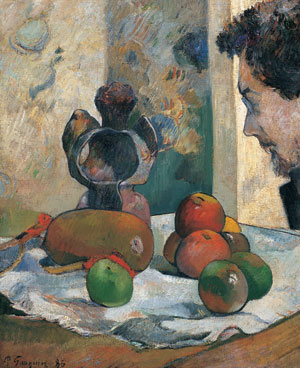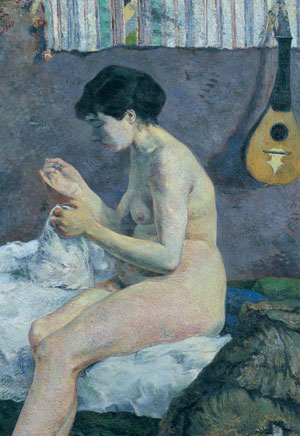"Art is either plagiarism or revolution."- Paul Gauguin

Paul Gauguin...Vase of Peonies I...1884... Oil on Canvas...National Gallery of Art, Washington...Collection of Mr. and Mrs. Paul Mellon...Image © Board of Trustees, National Gallery of Art
Besides a show of Diane Keaton-collected clown paintings in Los Angeles, this has got to be the most fascinating exhibition of middle-of-the-road art I've ever seen. Curated by Impressionist scholars, Dallas's own Dr. Richard Brettell and Anne-Birgitte Fonsmark, director of the Ordrupgaard Museum Copenhagen, the exhibition gathers together dozens of Paul Gauguin's early paintings, sculptures, and ceramics. These formative years have been nearly ubiquitously discounted as his "amateur" period, while he still worked as a stockbroker and before he apocryphally abandons his family to go beat up on Van Gogh and tortuously expire in Tahiti from syphilis caught from one of his 14 year old Polynesian mistresses. You can't champion much individually in this show, but there are flashes of brilliance buried beneath the Impressionist impasto and mannered plein aire technique, and a narrative tension builds, knowing where this is all heading. They say you need to work through your influences to find your own voice, and here is that idea writ large. The revolutionary Gauguin would become is only tantalizingly hinted at, but this show makes for a suspenseful and surprising prequel.
Visiting on a crowded afternoon, I jostled my way from work to work, enjoying the nicely literate, thorough and uncondescending wall texts. The show unfolds chronologically, beginning in 1875 with a couple of forgettable landscapes. Still Life with Oysters (1876) is done in virtual Dutch Master style, a bit stolid and awkward, but impressive for a stockbroker. Painting to painting you see his rapid digestion of more contemporary art trends and techniques. I found myself thinking how increasingly similar each subsequent painting was seeming to Camille Pissarro, a least favorite painter of a least favorite genre. The saving grace is that you know where it leads — to probably the most exciting and visceral artistic statement of the late 19th century; a similar exhibition of Pissarro would be a bullet train to Snoozeville. Among the many interesting nuggets I gleaned from those wall panels, I learned that Pissarro was indeed Gauguin's painting tutor for two years. As Gauguin's talent flowered, Pissarro supported and encouraged him, and together they helped organize a number of the Impressionist exhibitions that would shape the movement and help secure its place in history.

Paul Gauguin... Nude Study (Woman Sewing)... 1880... Oil on Canvas... Ny Carlsberg Glyptotek, Copenhagen
As pleasant and beneficent as Pissaro might have been, Gauguin was complex and conflicted, and this conflict seethes beneath the surface of nearly every work here, save the few places where it's just there, grabbing for your throat. In Nude Study (1880) you can feel the strain. It tries so damn hard, and has been hailed as perhaps his first "masterwork." I can dig Rubenesquery, but this figure is lumpen and poorly conceived, her flesh turbid with too many colors and manic brushwork. And the composition is bad — and not good-bad. The painting created a positive stir, probably because it is big (too big for his talents at that moment), and probably seemed just weird enough to merit attention at a time when weird was gaining clout. I suspect Gauguin hated it later. While struggling with the technical clichés of its era, it presages the Montmartre Bohemian clichés of a coming generation, replete even with mandolin on moody blue wall. Ack. Next to it is a much better, if more modest picture. Houses, Vanguard (1880) depicts French village rooftops. Flat planes crowd nearly the entire canvas surface, distinctive in its almost claustrophobic denseness, contrasting the typical landscape of the day: a Corot-ic template that up to this point Gauguin had somewhat slavishly mimicked. There is no gentle roadway leading you through an open pastoral scene, fields and sky discreetly dominant. Perhaps taking a compositional clue from the equally intense Degas, flat roofs lead the eye in a meandering route across the canvas, arriving at no clear resolution or point. And the brushwork begins to seem more assured; it's solid and downright Gauguin-like. As in many of the paintings here, there are flashes of the bold reds, greens, and yellows we associate with him, but they seem restrained, trapped beneath the Pissarroisms, Monetisms and Manetisms, the cataclysmic battle which he is inevitably closing in on.
There's a shocking, prophetic moment when arriving at The Little Dreamer (1881). A girl sleeps facing away, birds in flight on wallpaper above her, an eerie red doll or puppet totemically looming in the lower right corner. Suddenly, here is a fully realized late-Gauguin image, full of symbolism and indicating strange pagan forces. I doubt even he realized what it was he had done. He would almost exactly recreate the composition, significantly turning his brown odalisque's face to us, in what is perhaps his most famous painting, the disturbing Spirit of the Dead Watching (1892). The pleasant bourgeois existence he never could fully embrace is unconsciously critiqued in his Dreamer, shown undercut by mysteries little comprehended. And this, 20 years before Freud or Jung.
He often reached out to sculptural approaches when at an impasse, as Picasso, Matisse and others would do later. Anticipating the great Moderns, he helped free three-dimensional art from stifling dogmatism and aesthetic irrelevance, and in the process liberate his own art, escaping his most nefarious influences. After a couple early whiz-bang triumphs in marble, amazing but discountable for all but their sheer facility, it is in wood and clay that you see him developing the "Primativism" that was his revolution, long before it gains shape triumphantly in the paintings. They are generally small enough to have been overlooked in their time for the truly subversive expressions they are, but I am often amazed at how forward-looking his sculptures seem: weird, magical, and timeless. They must have raised some confused and skeptical eyebrows in their day.
Gauguin's increasing disaffection from the Paris scene, and the trends there so obviously stifling his development, led to an ill-conceived series of moves that ended at his in-laws' house in Denmark. Unable to find work, feeling increasingly trapped and isolated from his artistic compatriots, he became depressed and even suicidal, and this trying time is evidenced in Self Portrait (1885). Forced to work in the attic where the only solitude from his relatives was to be found (a story we can all relate to), he painted himself with a furtive weary gaze cast askance, unwilling to even face the viewer/himself. The ceiling presses down on him, the room is half-lit with a northern gloom. And yet, there he is, at last. We see the Gauguin we know, even if the technique still seems to cast about a bit, searching for its true form. A return to France would herald radical changes, for good or ill: greater assurance and renewed vision; a split with Pissarro, who'd found a new protégé to champion in a young Paul Signac; and of course, his leaving his family for the series of journeys that would essentially encompass the remainder of his existence.
The exhibition ends just short of his daemon-discovering move to Brittany, and the final painting before you exit is, in contrast, a fully-realized Tahitian masterpiece. The biggest crowd stood here, as if huddled around a fire, the dominant crimson giving off an almost palpable heat. The whole exhibition you are just waiting for him to stop trying to be an Impressionist, and be Gauguin. And you know he will, which should be the happy ending — but is it? We know how the story ends, and it is as full of tragedy as triumph. These works explicate the first half of that tale, and it is as painful as it is joyous. They teem with the exuberance and struggles of an artist finding his calling, his genius, his techniques — his soul, really. But you know going in that this story doesn't end with happy fat pink nudes or water lilies floating hazily on a pond. No happy Parisian picnics or luncheons with admiring young Modernist heroes as an old man. The struggle to mold himself into the bearded Parisian painter of middle-class mundanity would be abandoned. Like a shaman or yogi, he would go further and further, deeper into terra incognito, wherever his daemon led him. The literal move to Tahiti or elsewhere is in the end less interesting than his commitment to digging so deep into his own psyche, into the unknown, no matter down whatever dark corridors it took him. His place as a minor Impressionist surely would have been secure, as is amply demonstrated here. What makes this an amazing exhibition are not the actual pictures included, but the ones that aren't here at all. It is blockbuster show as cliffhanger, as conceit for another good story. It is a great act of scholarship that rarely feels ponderous or dull, and by context revivifies both the mostly humble art included, and my own fascination with Gauguin.
![]()
Post Script: I don't want to leave unmentioned an easily missed, peculiar text in a room outside the exhibit. In the corner of a gallery of ancient Pre-Columbian Meso-American art, a small wall panel tells that Gauguin was proudly part-Peruvian, and had lived there as a child. This odd little collection of wonderful artifacts, with this unheralded bit of information, seemed revelatory and was a highlight. This connection to another ancestral and cultural lineage helps to explain some of the obvious conflict he experienced with the paradigm in which he'd found himself, and would come to noticeably shift. A revolutionary indeed.
Images courtesy The Kimbell Art Museum
Titus O"Brien is an artist and writer currently living in Dallas




